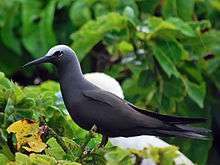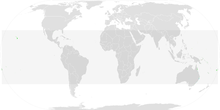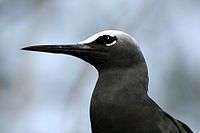Black noddy
The black noddy or white-capped noddy (Anous minutus) is a seabird from the family Laridae. It is a medium-sized species of tern with black plumage and a white cap. It closely resembles the lesser noddy (Anous tenuirostris) with which it was at one time considered conspecific. The black noddy has slightly darker plumage and dark rather than pale lores.
| Black noddy | |
|---|---|
 | |
| A black noddy at the Tubbataha Reef National Park in the Philippines. | |
| Scientific classification | |
| Kingdom: | Animalia |
| Phylum: | Chordata |
| Class: | Aves |
| Order: | Charadriiformes |
| Family: | Laridae |
| Genus: | Anous |
| Species: | A. minutus |
| Binomial name | |
| Anous minutus Boie, F., 1844 | |
 | |
| Global map of eBird reports of this species Year-Round Range Summer Range Winter Range | |
Taxonomy
The black noddy was first formally described by German naturalist and lawyer Friedrich Boie in 1844 under its current binomial name.[2] The genus name Anous is ancient Greek for "stupid" or "foolish". The specific name minutus is the Latin for "small".[3]
There are seven subspecies:[4]
- A. m. worcesteri (McGregor, 1911) - Cavilli Island & Tubbataha Reef (Sulu Sea)
- A. m. minutus Boie 1844 - northeast Australia & New Guinea to Tuamotu Archipelago
- A. m. marcusi (Bryan, 1903) - Marcus & Wake Islands through Micronesia to the Caroline Islands
- A. m. melanogenys Gray, 1846 - Hawaiian Islands
- A. m. diamesus (Heller & Snodgrass, 1901) - Clipperton Island (off western Mexico) & Cocos Island (off western Costa Rica)
- A. m. americanus (Mathews, 1912) - islands in the Caribbean Sea
- A. m. atlanticus (Mathews, 1912) - tropical islands in the Atlantic
Description
The black noddy has a length of 35–37 cm (14–15 in), a wingspan of 66–72 cm (26–28 in) and a weight of 98–144 g (3.5–5.1 oz). It has dark plumage and a pale crown.[5] There is a small white crescent under each eye and a white spot above. It has long tapering wings and a truncated tail. The sharply pointed bill is black. The feet are fully webbed and are black in most subspecies[6] but orange in melanogenys.[7]
Behaviour
These birds may have become known as "noddies" because of the behaviour of both sexes as they constantly dip their heads during their breeding display. They are very tolerant of humans even to the extent that they can be picked up off the nest. They feed on fish and squid which they gather by flying low over the surface of the sea and picking them up.[6] They may associate with other seabirds in areas where predatory fish are driving small fish to the surface.[1]
The nests of these birds consist of a level platform, often created in the branches of trees by a series of dried leaves covered with bird droppings. One egg is laid each season, and nests are re-used in subsequent years. The trees used for this purpose are various but the Pisonia is most often used, and in large trees, there are often several nests.[8] The guano produced by these birds adds large quantities of nutrients to the soil which is of great importance to the plant communities on coral islands.[9]
Distribution
The black noddy has a worldwide distribution in tropical and subtropical seas, with colonies widespread in the Pacific Ocean and more scattered across the Caribbean, central Atlantic and in the northeast Indian Ocean. At sea it is usually seen close to its breeding colonies within 80 km of shore. Birds return to their colonies, or to other islands, to roost at night.
Cultural significance
This is one of landfinding birds whose daily foraging flights were traditionally employed by Pacific navigators to locate unseen atolls.[10]
Gallery
 Nesting in Tubbataha Reef National Park, Philippines
Nesting in Tubbataha Reef National Park, Philippines- Calling at colony.
 Nesting on Heron Island, Australia
Nesting on Heron Island, Australia Black noddy with chick
Black noddy with chick Black noddy head
Black noddy head- Common noddy head - note stouter beak, greyer cap
- Black noddy
References
- BirdLife International (2012). "Anous minutus". IUCN Red List of Threatened Species. 2012. Retrieved 26 November 2013.CS1 maint: ref=harv (link)
- Boie, Friedrich (1844). "Nuszüge aus dem Cystem der Ornithologie". Isis von Oken (in German and Latin). 1844. Column 188.
- Jobling, James A. (2010). The Helm Dictionary of Scientific Bird Names. London: Christopher Helm. pp. 48, 256. ISBN 978-1-4081-2501-4.
- Gill, Frank; Donsker, David, eds. (2019). "Noddies, gulls, terns, auks". World Bird List Version 9.2. International Ornithologists' Union. Retrieved 24 June 2019.
- Gochfeld, M.; Burger, J.; Kirwan, G.M.; Garcia, E.F.J. "Black Noddy (Anous minutus)". In del Hoyo, J.; Elliott, A.; Sargatal, J.; Christie, D.A.; de Juana, E. (eds.). Handbook of the Birds of the World Alive. Lynx Edicions. Retrieved 17 April 2017.
- "Black Noddy". ARKive. Archived from the original on 2013-12-03. Retrieved 2013-12-12.
- Hawaii Audubon Society. (2005). Hawaii's birds (6th ed.). Honolulu: Hawaii Audubon Society. ISBN 1-889708-00-3. OCLC 64201016.
- Barnes, A.; Hill, G. J. E. (1989). "Census and distribution of Black Noddy Anous minutus nests on Heron Island, November 1985". Emu. 89 (3): 129–134. doi:10.1071/MU9890129.
- Allaway, W.G.; Ashford, A.E. (1984). "Nutrient input by seabirds to the forest on a coral island of the Great Barrier Reef". Marine Ecology Progress Series. 19: 297–298. Bibcode:1984MEPS...19..297A. doi:10.3354/meps019297.
- Crowe, Andrew (2018). Pathway of the Birds: The Voyaging Achievements of Māori and their Polynesian Ancestors. Auckland: David Bateman Ltd. p. 93.
- Guager, V.H. (1999) Black Noddy Anous minutus, in The Birds of North America, No412 (Poole, A. and Gill, F. eds) The Academy of Natural Sciences, Philadelphia, and The American Ornithologists’ Union, Washington, D.C.
External links
| Wikimedia Commons has media related to Anous minutus. |
| Wikispecies has information related to Anous minutus |
